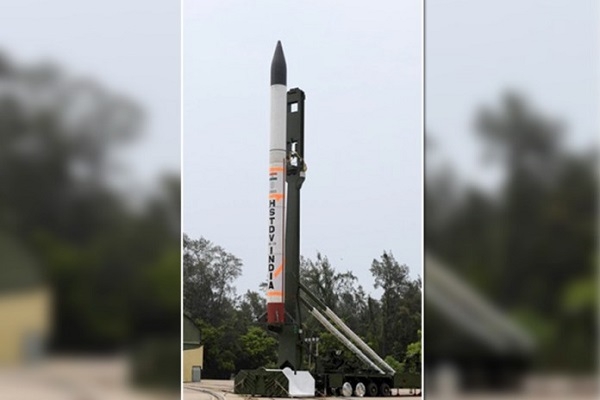India’s Hypersonic Duality
Total Views |
India has become the fourth country – after United States, Russia and China – to inch towards operationalization of scramjet-based hypersonic vehicles. On 7th September 2020, India’s Defence Research Development Organization (DRDO) successfully tested the air-breathing scramjet engine of the Hypersonic Technology Demonstrator Vehicle (HSTDV) mounted on a proven first-stage solid-fuel rocket engine. The HSTDV, after separation from the first-stage at an altitude of 30 kilometers, went hypersonic, above Mach 7, for more than 20 seconds. This test has come at a time when India’s peaceful economic growth and growing international stature is making both Pakistan and China bellicose against it.
This is not the first occasion when India has gone hypersonic. The DRDO and its industrial partners have already productionized solid-fuel ballistic hypersonic missiles. The Shaurya is a two-stage solid-fuel ballistic missile, which goes hypersonic in the terminal stage of its surface-to-surface flight up to speeds of Mach 7.5. The Pradyumna ballistic missile, part of the Prithvi Air Defence System, is also capable of attaining hypersonic speeds of up to Mach 5. The Indian Space Research Organization (ISRO) too has a hypersonic vehicle in its store. The first of the tests of ISRO’s Reusable Launch Vehicle Technology Demonstrator (RLV-TD), that took place in 2016, was called as the Hypersonic Flight Experiment. The RLV-TD space-plane was taken to a high altitude of around 65 km as the second-stage of a conventional Polar Satellite Launch Vehicle (PSLV) booster and then was released to descend back to the surface, owing to gravity, at hypersonic speeds of around Mach 5. In the coming months, ISRO intends to evaluate the scramjet engine on the RLV-TD, which can speed it to higher Mach numbers.

The international contest for hypersonic vehicles has intensified both in the weapons and two- (TSTO) and single-stage-to-orbit (SSTO) space-plane technology realms. Unlike the air-breathing scramjet ‘cruise’ vehicles, SSTO and TSTO space-planes have air-breathing scramjet ‘accelerators’ that equip them to swiftly escape Earth’s gravitational clutches. Reusable space-planes also experience extremely high Mach numbers (>20) as they re-enter Earth’s atmosphere on their way to the surface.
The U.S. has already undertaken numerous clandestine flights of its Boeing X-37 TSTO space-plane in the Earth’s orbit; the recent in May 2020. The now space-proven X-37 is said to be operating at extremely high hypersonic speeds, up to Mach 25. China claims to have undertaken orbital test, between 4th and 6th September 2020, of its spaceplane that has long gone by the name of Shenlong. However, it was unable to provide any validation of the space-plane before or after the flight. Be that as it may, between space-planes and weapons, the hypersonic scramjet contest is truly heating up in the weapons domain and there’s a reason for it.
Today, dense and precise air defense systems can intercept conventional subsonic ballistic and cruise missiles easily. This absence of deterrence is obliging militaries equipped with strong R&D back-ends to develop scramjet-based hypersonic missiles with much lower detection signatures than their conventional counterparts. Advantageously, hypersonic scramjet vehicles also fly at lower altitudes and evade ground-based radars making their detection extremely difficult over longer distances.
The paradigm shift from conventional fuel to scramjet-based hypersonic missiles is also triggering the evolution of air-defense systems. The shift is compelling the advancement of the entire air-defense kill chain from finding, fixing, tracking, targeting, engaging, and assessing – better known as F2T2EA in defence-technology communes – the incoming missile or projectile. Given these advancements, the other three countries in this first-movers club have fast-tracked operationalization of scramjet-based hypersonic weapons in the past one year.

China announced the operationalization of the Dongfeng-ZF, a scramjet-powered hypersonic glide vehicle tipped on the Dongfeng-17, during their 2019 Military Day Parade. This was followed by the Russian Strategic Missile Troops operationalizing the Avangard hypersonic glide vehicle tipped on the UR-100N missile on 27th December 2019. A few months later, on 19th March 2020, the Pentagon’s Missile Defense Agency tested the Common-Hypersonic Glide Body successfully; this too was tipped on a modified version of the retired Polaris missile now called as the Strategic Target System (STARS).
In the past one year, several geopolitical hotspots have begun to blaze, be it Tibet, Taiwan, Gilgit-Baltistan, East China Sea, Levant, Eastern Mediterranean and the Persian Gulf. Russia and United States realize that any skewing of the equilibrium will lead to blazing of these hotspots. Therefore, to continue with their mutual détente, in April 2020, Russia’s Foreign Minister Sergey Lavrov initiated conversation with the U.S. Secretary of State Michael Pompeo to bring hypersonic vehicles under the ambit of the revised version of New Strategic Arms-Reduction Treaty (New START), which will succeed the current one that expires on 5th February 2021. The current treaty is largely limited to delivery systems that includes both, UR-100N and the Polaris, but does not include hypersonic payloads or warheads. Whether hypersonic vehicles are treated as delivery systems or warheads in the next revision of the New START is yet to be seen. The Trump Administration intends to invite China to be part of the revised START but the latter has not expressed spirit nor eagerness.
New Delhi has prudently chosen to develop hypersonic in a dual-use manner, one civilian – as space-plane – and the other military – as a missile weapon. This dual-use capability will give New Delhi the leverage to deal with its two belligerent neighbors yet at the same time be ready to develop arms-reduction agreements. But first, it should use the hypersonic duality to counter the looming and grave threat perception in the sub-continent emanating from the Sino-Pak axis.

